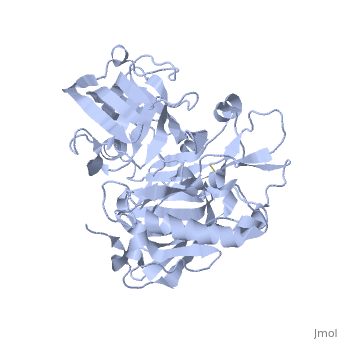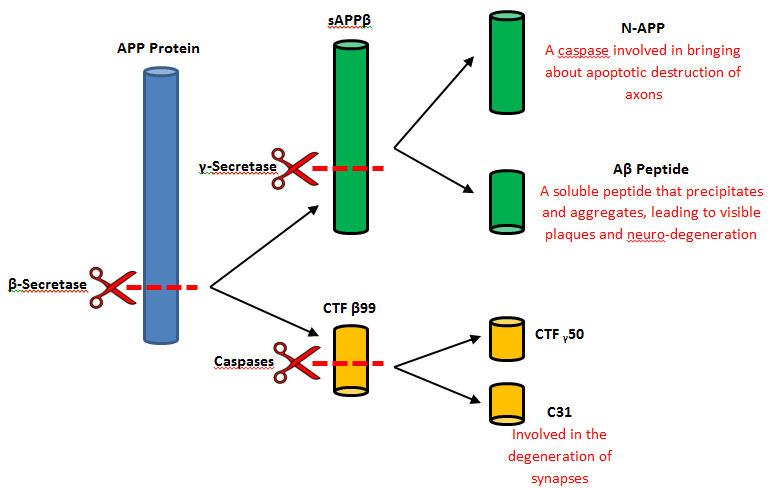Beta Secretase (BACE1) 1SGZ
From Proteopedia
| Line 15: | Line 15: | ||
BACE-1 is a type-1 integral membrane glycoprotein that is affected by the positions on the outer domains of amino acids <ref name="six">Venugopal, C.; Demos, C. M.; Rao, K. S. J.; Pappolla, M. A.; Sambamurti, K. Beta-secretase: Structure, Function, and Evolution. CNS & Neurological Disorders Drug Targets. [Online] 2008. 7(3), 278–294. | BACE-1 is a type-1 integral membrane glycoprotein that is affected by the positions on the outer domains of amino acids <ref name="six">Venugopal, C.; Demos, C. M.; Rao, K. S. J.; Pappolla, M. A.; Sambamurti, K. Beta-secretase: Structure, Function, and Evolution. CNS & Neurological Disorders Drug Targets. [Online] 2008. 7(3), 278–294. | ||
http://www.ncbi.nlm.nih.gov/pmc/articles/PMC2921875/ | http://www.ncbi.nlm.nih.gov/pmc/articles/PMC2921875/ | ||
| - | </ref> . BACE-1 prefers the cleavage of longer substrates over smaller peptide based substrates due to approximate acidic pH of 4.5 resulting from the cleavage. The acidic and polar environment of the enzyme allow a wide variety of substrates to bind to the membrane. Cleavage of soluble substrates is possible in external environment due to the enzyme’s high values of Km failing to observe in the internal environment <ref>Shimizu, H.; Tosaki, A.; Kaneko, K.; Hisano, T.; Sakurai, T.; Nukina, N. Crystal Structure of an Active Form of BACE1, an Enzyme Responsible for Amyloid Beta Protein Production. Molecular and Cellular Biology [Online] 2008, 28(11), 3663-671. | + | </ref> . BACE-1 prefers the cleavage of longer substrates over smaller peptide based substrates due to approximate acidic pH of 4.5 resulting from the cleavage. The acidic and polar environment of the enzyme allow a wide variety of substrates to bind to the membrane. Cleavage of soluble substrates is possible in external environment due to the enzyme’s high values of Km failing to observe in the internal environment <ref name="seven">Shimizu, H.; Tosaki, A.; Kaneko, K.; Hisano, T.; Sakurai, T.; Nukina, N. Crystal Structure of an Active Form of BACE1, an Enzyme Responsible for Amyloid Beta Protein Production. Molecular and Cellular Biology [Online] 2008, 28(11), 3663-671. |
http://mcb.asm.org/content/28/11/3663.full.pdf+html | http://mcb.asm.org/content/28/11/3663.full.pdf+html | ||
</ref>. The two catalytic aspartate residues that reside in the active site of BACE-1 are Asp 32 and Asp 228<ref name="six">Venugopal, C.; Demos, C. M.; Rao, K. S. J.; Pappolla, M. A.; Sambamurti, K. Beta-secretase: Structure, Function, and Evolution. CNS & Neurological Disorders Drug Targets. [Online] 2008. 7(3), 278–294. | </ref>. The two catalytic aspartate residues that reside in the active site of BACE-1 are Asp 32 and Asp 228<ref name="six">Venugopal, C.; Demos, C. M.; Rao, K. S. J.; Pappolla, M. A.; Sambamurti, K. Beta-secretase: Structure, Function, and Evolution. CNS & Neurological Disorders Drug Targets. [Online] 2008. 7(3), 278–294. | ||
http://www.ncbi.nlm.nih.gov/pmc/articles/PMC2921875/ | http://www.ncbi.nlm.nih.gov/pmc/articles/PMC2921875/ | ||
| - | </ref>. The active site of BACE-1 has a flexible antiparallel -hairpin, also known as a flap, which is found in the residues of 67 to 77, that controls the accessibility of the substrate to the active site, and the flap also has to set the substrate in the correct orientation for catalysis. In an open conformation, the active site allows the substrate to enter without any difficulty and regulates its activity. In an inactive form, the binding affinity to the inhibitor is decreased, which then lowers the substrate binding and enzymatic activity. For the closed conformation, the flap with the inhibitor bound is firmly secured in place <ref>Shimizu, H.; Tosaki, A.; Kaneko, K.; Hisano, T.; Sakurai, T.; Nukina, N. Crystal Structure of an Active Form of BACE1, an Enzyme Responsible for Amyloid Beta Protein Production. Molecular and Cellular Biology [Online] 2008, 28(11), 3663-671. | + | </ref>. The active site of BACE-1 has a flexible antiparallel -hairpin, also known as a flap, which is found in the residues of 67 to 77, that controls the accessibility of the substrate to the active site, and the flap also has to set the substrate in the correct orientation for catalysis. In an open conformation, the active site allows the substrate to enter without any difficulty and regulates its activity. In an inactive form, the binding affinity to the inhibitor is decreased, which then lowers the substrate binding and enzymatic activity. For the closed conformation, the flap with the inhibitor bound is firmly secured in place <ref name="seven">Shimizu, H.; Tosaki, A.; Kaneko, K.; Hisano, T.; Sakurai, T.; Nukina, N. Crystal Structure of an Active Form of BACE1, an Enzyme Responsible for Amyloid Beta Protein Production. Molecular and Cellular Biology [Online] 2008, 28(11), 3663-671. |
http://mcb.asm.org/content/28/11/3663.full.pdf+html | http://mcb.asm.org/content/28/11/3663.full.pdf+html | ||
</ref>. | </ref>. | ||
Revision as of 02:21, 13 April 2016
Beta-secretase, also known as BACE or Memapsin 2, is encoded by the gene BACE1. Beta-secretase is a proteolytic, transmembrane enzyme with two active sites on the extracellular region. It is associated with processing amyloid precursor protein (APP), which is an integral membrane protein.[1] A malfunction in the processing of APP results in the formation of the peptide amyloid beta. Amyloid-beta is a neurotoxic peptide segment that aggregates into plaques. These plaques are the primary component of plaques found in individuals with Alzheimers Disease. [2] Other biological associations of this enzyme include modulating myelination in the central and peripheral nervous systems.[3]
Enzyme Class
Beta-secretase is an enzyme that is classified as a class 3 enzyme, which are hydrolases [4]. The enzyme acts on breaking peptide bonds and therefore is also considered a peptidase and belongs to the subclass of aspartic acid endopeptidases.[5]
Structure
| |||||||||||
References
- ↑ Ghosh, A.; Kumaragurubaran, N.; Hong, L.; Koelsh, G.; Tang, J. Memapsin 2 (Beta-Secretase) Inhibitors: Drug Development. CAR Current Alzheimer Research. [Online] 2008, 5, 121–131. http://jamesmadisonva.library.ingentaconnect.com/content/ben/car/2008/00000005/00000002/art00004
- ↑ John, V.; Beck, J. P.; Bienkowski, M. J.; Sinha, S.; Heinrikson, R. L. Human β-Secretase (BACE) And BACE Inhibitors. ChemInform. [Online] 2004, 35, 4625-4630. http://pubs.acs.org/doi/pdf/10.1021/jm030247h
- ↑ Hu, X.; Hicks, C. W.; He, W.; Wong, P.; Macklin, W. B.; Trapp, B. D.; Yan, R. Bace1 Modulates Myelination in the Central and Peripheral Nervous System. Nature Neuroscience Nat Neurosci. [Online] 2006, 9, 1520–1525. http://www.nature.com/neuro/journal/v9/n12/abs/nn1797.html
- ↑ Nomenclature Committee of the International Union of Biochemistry and Molecular Biology. The Enzyme List Class 3 — Hydrolases. http://www.enzyme-database.org/downloads/ec3.pdf
- ↑ DBGET Search. KEGG ENZYME: 3.4.23.46. http://www.genome.jp/dbget-bin/www_bget?ec:3.4.23.46
- ↑ 6.0 6.1 Venugopal, C.; Demos, C. M.; Rao, K. S. J.; Pappolla, M. A.; Sambamurti, K. Beta-secretase: Structure, Function, and Evolution. CNS & Neurological Disorders Drug Targets. [Online] 2008. 7(3), 278–294. http://www.ncbi.nlm.nih.gov/pmc/articles/PMC2921875/
- ↑ 7.0 7.1 Shimizu, H.; Tosaki, A.; Kaneko, K.; Hisano, T.; Sakurai, T.; Nukina, N. Crystal Structure of an Active Form of BACE1, an Enzyme Responsible for Amyloid Beta Protein Production. Molecular and Cellular Biology [Online] 2008, 28(11), 3663-671. http://mcb.asm.org/content/28/11/3663.full.pdf+html



